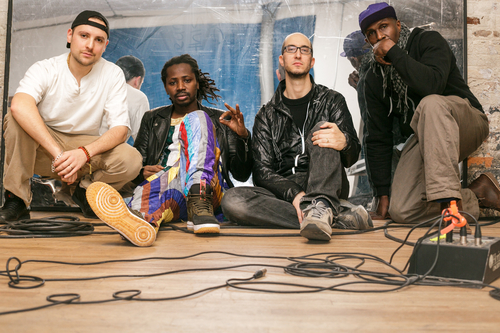For at least the past fifty years, the most important and exciting site of new fusions of music has been in Jazz. Perhaps this is owing to its roots in collective improvisation and musical play, or in Jazz’s consistent pursuit of innovative timbres, rhythms, and forms. Fusions with Latin music go back at least to Charles Mingus (Haitian Fight Song) and the innovations of Miles Davis in fusing Jazz with Rock (See his Bitches Brew) seem to have opened up the possibility of many others. In the past few years, a new fusion with rap and hip-hop has been showing us ways in which two African-American musical innovations can come together in a sort of musical dialogue.
The group “Sélébéyone” takes its name from a Wolof word, meaning “intersection” or a place between the borders where two entities may meet and transform into something entirely new. That is exactly what happens in their music where the border of hip hop (rap) meets at the edges of jazz. They performed numbers from their recent self-titled album as part of the Ecstatic Music Festival at Merkin Hall on March 27.

www.stevelehman.com
Photo by Willie Davis
The group consists of musicians from the United States and Senegal. Steve Lehman and Maciek Lasserre on saxophones, Damion Reid on percussion, bass player Chris Tordini, keyboardist Carlos Homs, and two rappers, HPrizm and Gaston Bandimic.
Bandimic raps in Wolof, the indigenous language of Senegal, Gambia, and Mauritiana. Wolof, interestingly, is not a tonal language, which means that pitch difference does not convey meaning (unlike, say, Mandarin) thus the rhythmic rush of the language and Bandimic’s rapping may come naturally from the language itself. HPrizm, by contrast, offered slower, more resonating lines, often taking advantage of his two-microphone set up, in which one was set to a high reverb, extending his words in a long echoing resonance.
HPrizm has been active in the experimental hip hop scene for some time, especially with his project, the Antipop Consortium Collective.
Drummer Damion Reid is perhaps best known for his work with the Robert Glasper Trio, the inventive trio that won a Grammy for best R&B album with just such a collaboration between Jazz and Hip Hop. His is a cymbal-centered style, that relies less on big resonating toms or typical snares and more on the variety of metals in his kit. This makes some sense in the context of Sélébéyone for the group tends to rely on robust synthesized sounds for its lower register, laying down big electronic textures to fill out those sub-audible ranges. Reid’s cymbals float above this this bass, producing an astonishing variety of timbres and resonances.
The saxophones created thick constellations of sounds, with long arpeggiated gestures that defy harmonic analysis. Lasserre, on soprano, created sonic depth with swirling motions that moved his horn closer to and further from his microphone. The reverb applied to the instrument gave it even more warmth. Lehman’s alto sax playing is virtuosic and defies easy description. The harmonic density of his solos is breathtaking.
The overall effect of this group is electrifying. On the one hand, the music is mesmerizing, with its thick electronic foundation and eddies of saxophones above it all, with shimmering cymbals and brittle piano above it all. On the other hand, their songs are formal structures with breaks for rappers in two languages. The electronics often use recordings of people, not in English, as a starting point, and it would be interesting to know if the rappers were engaging in ideas presented in hat recorded material. To a non-African listener, the effect is one of general African evocation.
HPrizm, Gaston Bandimic, and Maciek Lasserre all practice Sufism, a mystical branch of Islam which, in Senegal, has coalesced in the Mouride Brotherhood, founded in 1883 by Amadou Bomba, to whose memory the group’s last song was dedicated.
The group has uploaded the first song, “Laamb” on Youtube :

